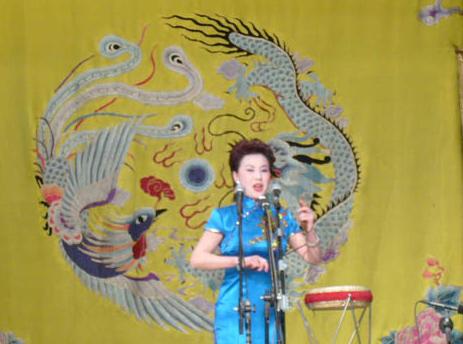
Jingdong Drum Song is a form of singing and recital in Jingdong dialect with drum accompaniment. It is comprised of singing by one performer who stands and beats the drum as well as accompaniment of Sanxian (3-string Chinese guitar played with a plectrum), dulcimer and other musical instruments by other performers. Jingdong Drum Song came into existence in the middle period of the Qing Dynasty, with different appellations in different periods and places. Originated in Sanhe and Xianghe regions in Jingdong, Hebei Province as well as Baodi region in Tianjin, Jingdong Drum Song was prevailing in Langfang, Chengde, Baoding and Tangshan in Hebei Province, Huairou in Beijing and Baodi in Tianjin. It was mainly performed in small-scale Quyi (Chinese folk art forms) performing sites at the initial stage, with storytelling as the major form of performance. In the early 1930s, Liu Wenbin played a role in Cases of Lord Liu which was broadcast by Tianjin Commercial Broadcasting Station and got extremely popular with the mass. From then on, Jingdong Drum Song was increasingly enhanced in its influential force and was gradually spread to Beijing, Tangshan and other places.
Incipient music of Jingdong Drum Song was originated in the late Qing Dynasty and became prevalent in the east of Beijing. It got popular in Tianjin after Old Cripple Zhang (folk artist) made performance in Tianjin and then took apprentices and handed down his artistic skills there. The appellation "Jingdong Drum Song" had not come into existence at that time, with its tune having not taken shape. Such music was sung with "timid" tone, featuring fewer lyrics and more tunes as well as accompaniment of iron sheet beating. Only the prelude "Before storytelling, I would like to start with…" lasted over ten minutes. Due to the slow rhythm, it usually happened that no audience would sit out the performance. Afterwards, Liu Wenbin and other artists in Tianjin learned from other genres of Chinese folk art and carried out adventurous reform of the aria. Through making reference to the rhythm of Opening of Temple Gate and integrating the music of declined tune and flat tune, they changed the original singing mode featured by slow commencement and long aria, improved the aria of "Thirteen Coughs", and created a new tune which is considerably different from the original one. It is at that time that such basic aria of Jingdong Drum Song took shape in Tianjin. It is said that there are two modes of aria music: Gong tone and Zhi tone (gong and zhi are among the five notes of the ancient Chinese five-tone scale, corresponding to 1 and 5 respectively in numbered musical notation). Analysis on the opern reveals that such type of music is characterized by alternative modes, with Zhi tone as the major one.





